Luis Estévez, a Cuban-born American designer, was a prominent figure in the fashion world from the early 1950s until his retirement in 1997. Estévez’s journey into fashion began after a brief stint at Lord & Taylor, followed by formal training at the Traphagen School of Fashion in New York. His talent and ambition led him to Paris, where he worked under the prestigious house of Jean Patou, further refining his craft. By 1955, Estévez had returned to New York and launched his own label, Grenelle-Estévez, where he quickly became known for his innovative designs that combined elegance with sensuality. His creations were marked by figure-flattering silhouettes, dramatic necklines, and high slits, making them a favorite among Hollywood’s elite and fashionable women across America.
Throughout his illustrious career, Estévez demonstrated an ability to adapt to the changing tides of fashion while maintaining his signature style. In the 1960s, he expanded his repertoire to include swimwear for Sea Darlings and men’s wear for Jaymar, showcasing his versatility as a designer. His collaboration with actress Eva Gabor in the 1970s further cemented his status as a designer who could blend Hollywood glamour with high fashion. Estévez was also a favorite among First Ladies, dressing the likes of Betty Ford and Nancy Reagan, which speaks to his influence and the timeless appeal of his designs.
As fashion trends evolved, so did Estévez’s brand. His logos and tags, which changed over the decades, provide a fascinating glimpse into the brand’s evolution and the broader shifts in the fashion industry. From the handwritten scripts of the 1950s to the bold, structured fonts of the 1980s, each iteration of the Estévez logo tells a story of the brand’s growth and adaptation. Collectors and vintage enthusiasts now look to these logos and tags not just as identifiers but as markers of a particular era in fashion history. Estévez’s legacy is one of elegance, innovation, and a keen understanding of the female form, making his pieces highly sought after by those who appreciate the enduring allure of vintage fashion.
How to tell if Estevez is vintage from the logo
Estevez, known for its timeless and elegant designs, has undergone several logo changes over the years. These changes reflect the evolution of fashion trends and the brand’s own growth. Identifying the era of an Estevez piece through its logo can be a valuable tool for vintage collectors and enthusiasts. Below is a breakdown of the Estevez logos from different eras based on the images provided.
1950s Estevez logo
- This logo features a stylized and handwritten script, capturing the elegance and sophistication associated with mid-century fashion.
- The ‘Estevez’ text is written in a flowing, cursive style, which was common for luxury brands during this time.
- Below the main logo, there is additional text in a more straightforward font, indicating a collaboration or specific line such as “For Grenelle.”
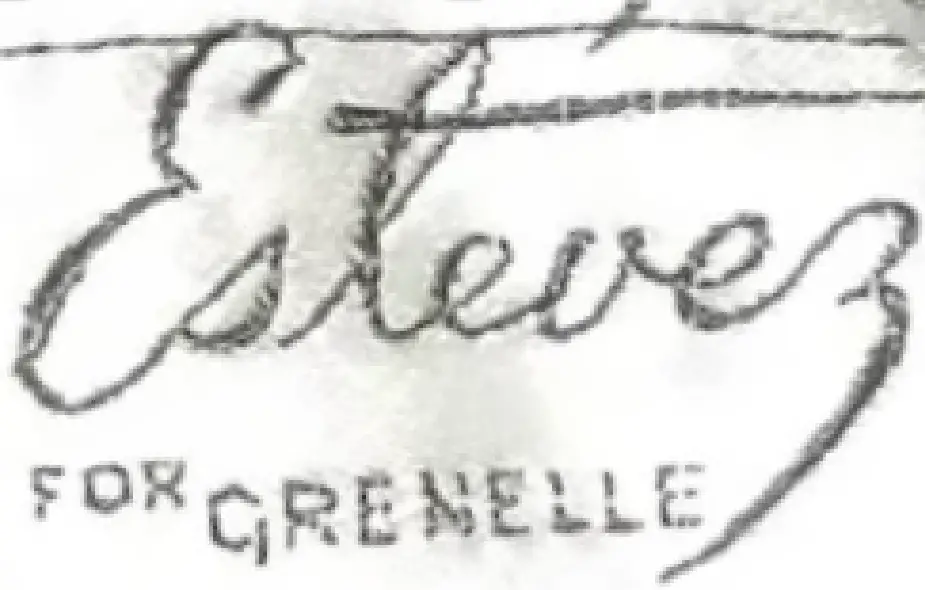
1950s Estevez logo
1950s to 1980s Estevez logo
- This logo adopts a more formal and structured serif font, which represents the brand’s shift towards a more classic and enduring style.
- The letters are well-defined with sharp edges, indicating a more professional and established brand image.
- This logo is less ornamental and more about clarity and recognition, reflecting the evolving design aesthetics of the time.

1950s to 1980s Estevez logo
How to tell if Estévez is vintage from the tags
The evolution of Estévez tags over the decades reflects the brand’s shift in design and branding strategies. From the early days when Luis Estévez made his mark in the fashion world, the tags have gone through various changes, each era introducing a new look that mirrored the fashion trends of the time. Identifying a vintage Estévez piece can be done by closely examining the tag, which can provide valuable clues about the garment’s origin.
Can’t figure out your vintage tags or labels? Upload a picture on our vintage tag identification page, and we’ll assist you!
1950s vintage Estévez tags
- Tags often feature the full name “Luis Estévez” in bold serif lettering.
- The design is simple and understated, with a focus on the designer’s name.
- Tags are typically white with black or gold text.
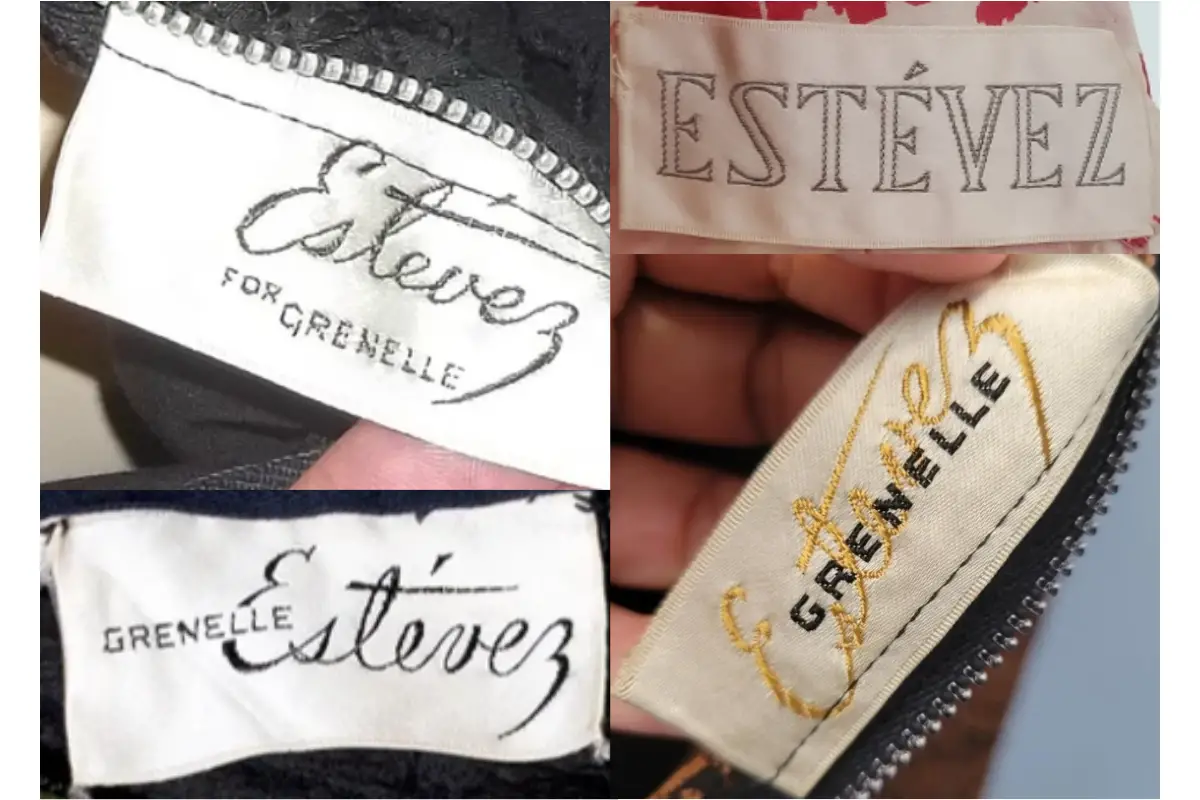
1950s Estevez tags
1960s vintage Estévez tags
- The tags from this era start to emphasize the brand name “Estévez” more prominently.
- Satin or woven labels are common, featuring elegant and refined lettering.
- Some tags include “Estévez for Grenelle,” indicating a specific line or collaboration.
- Tags often have a signature-style font, reflecting the designer’s personal touch.
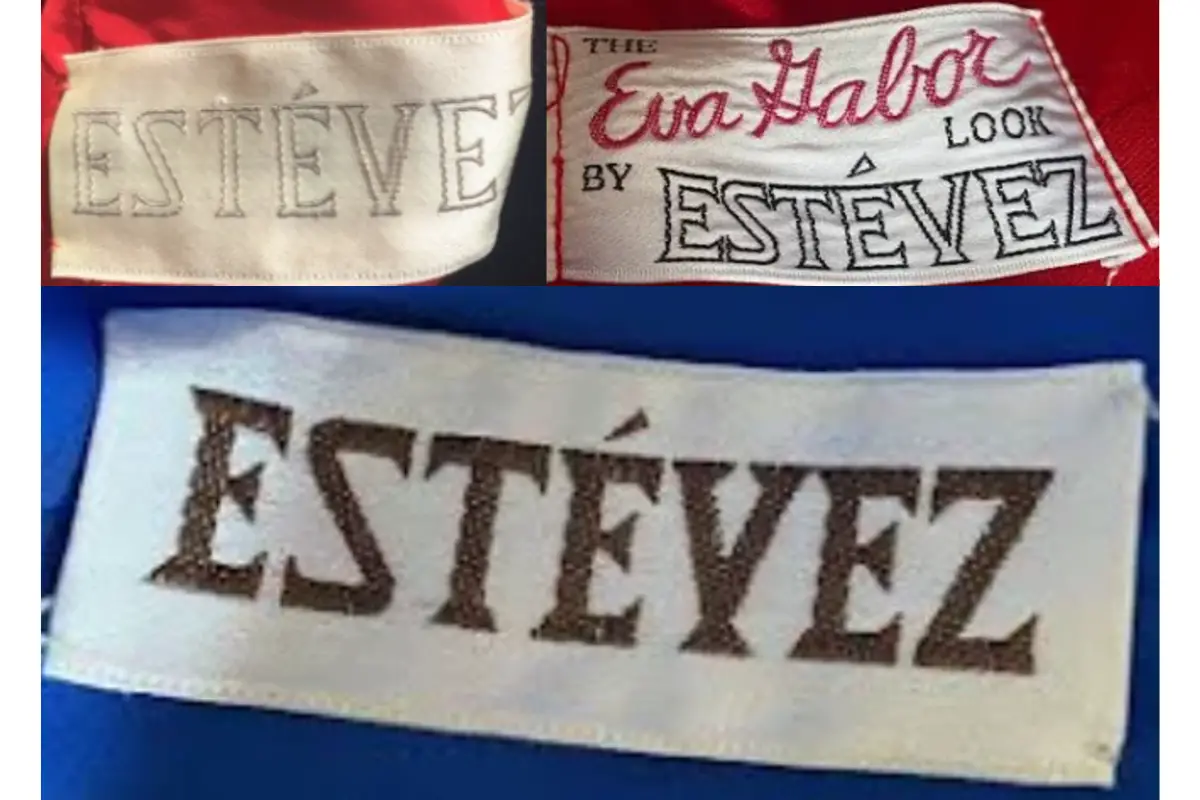
1960s Estevez tags
1970s vintage Estévez tags
- Tags during this period feature the Estévez name in bold, uppercase lettering.
- Introduction of more vibrant tag colors, such as red or gold borders.
- Some tags include “The Eva Gabor Look by Estévez,” highlighting a notable collaboration.
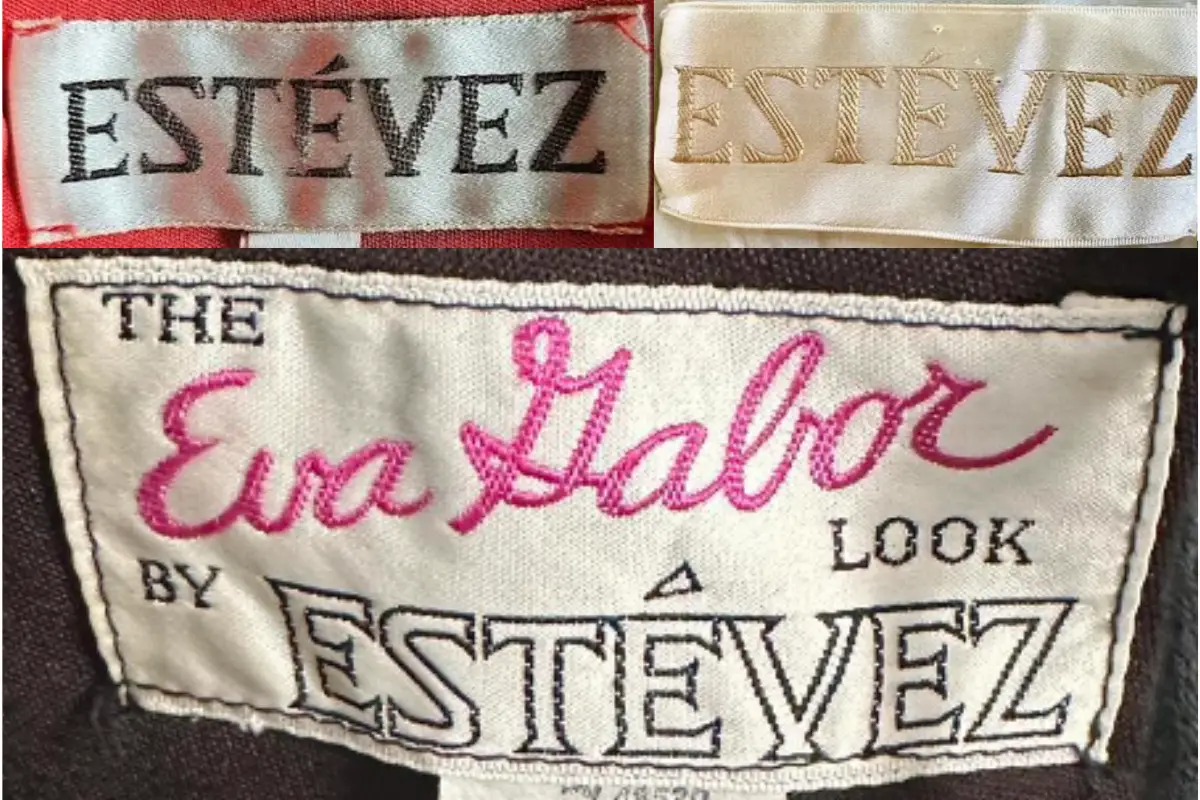
1970s Estevez tags
1980s vintage Estévez tags
- The tags prominently display the Estévez name, often in a serif font.
- Colors used in the tags range from neutral tones to more metallic shades like gold.
- Tags may include sub-labels like “Grenelle,” indicating different lines under the Estévez brand.
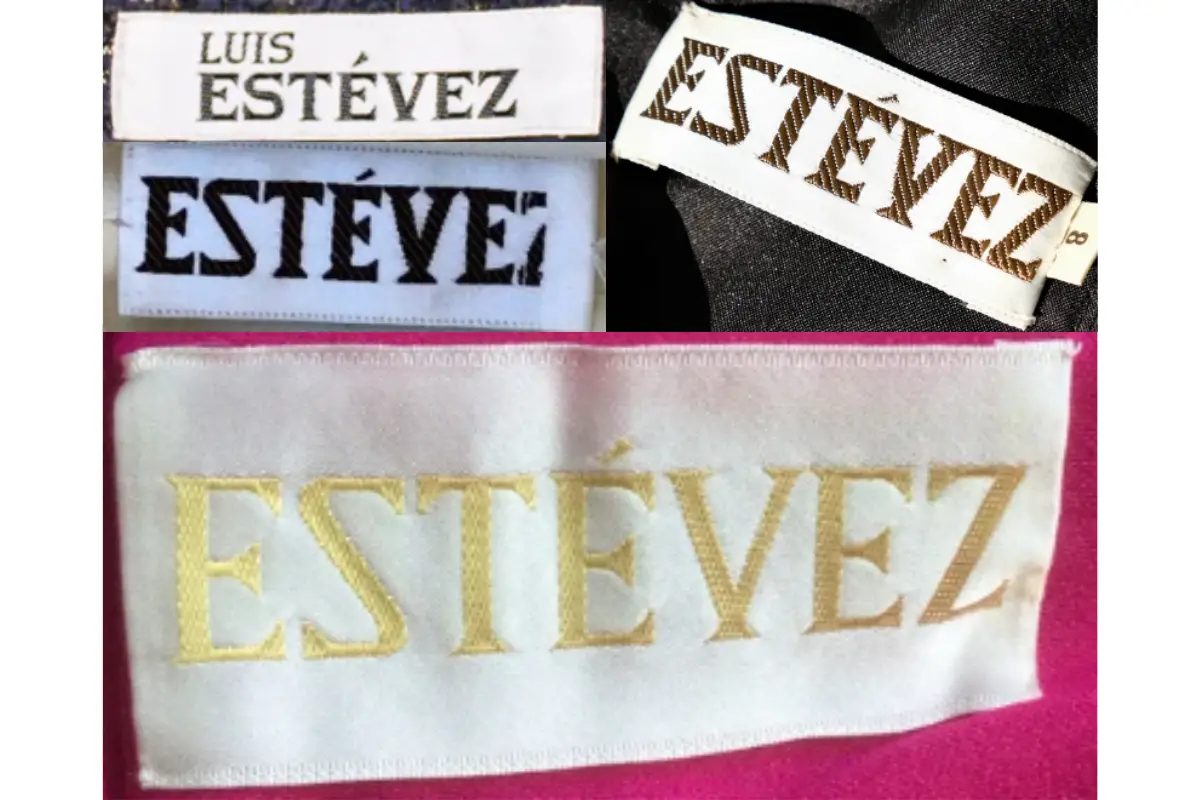
1980s Estevez tags



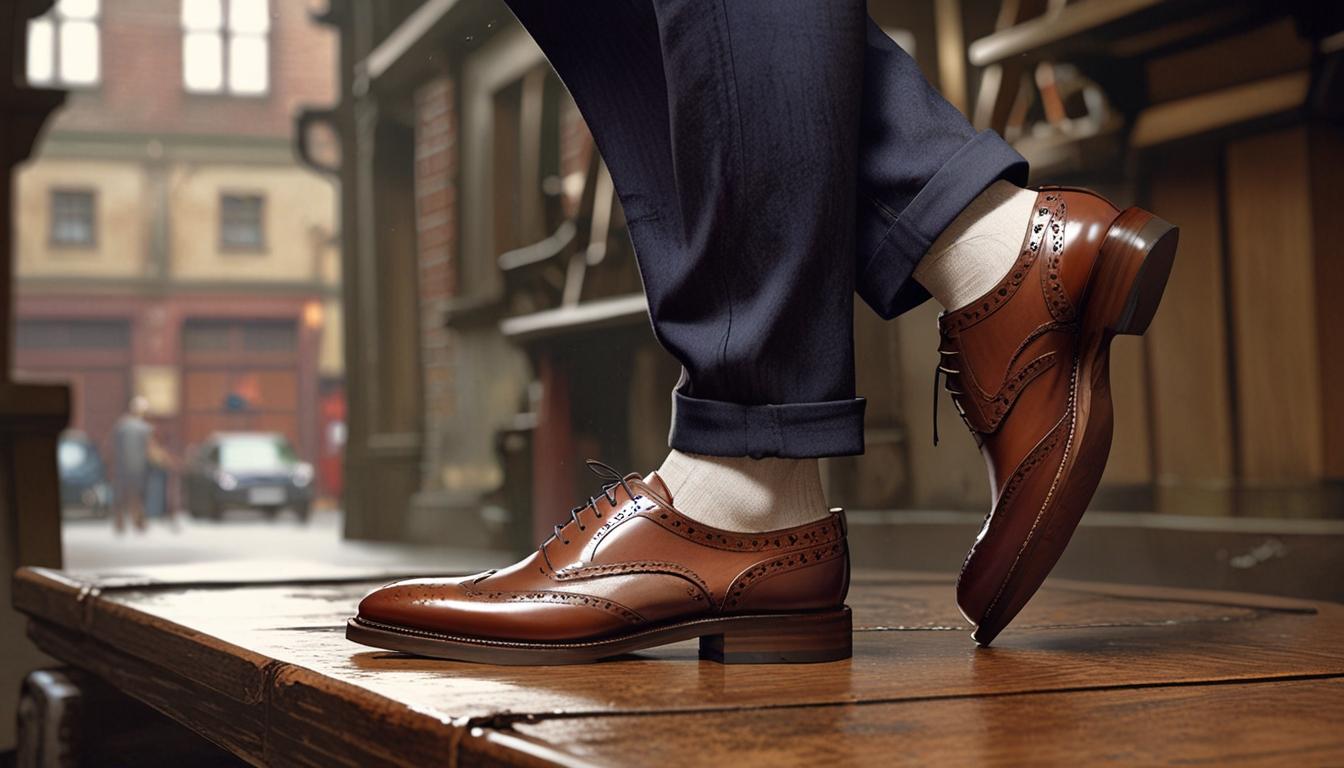
Usually I do not read post on blogs, but I would like to say that this write-up very pressured me to try and do it!
Your writing taste has been surprised me. Thank you,
very great article.
Do you mind if I quote a couple of your articles as long as
I provide credit and sources back to your webpage? My website is in the exact same area of interest as yours and my visitors
would really benefit from some of the information you present
here. Please let me know if this alright with you.
Thank you!
I love your blog.. very nice colors & theme. Did you create this website yourself or did you hire someone to do
it for you? Plz respond as I’m looking to create my own blog
and would like to find out where u got this from. cheers
Great article! This is the kind of information that should be shared around the web.
Disgrace on Google for now not positioning this submit higher!
Come on over and seek advice from my site . Thank you
=)
Heya i’m for the first time here. I came across this board and I
to find It really useful & it helped me out a lot.
I hope to present one thing back and help others
such as you helped me.
I like what you guys are up too. Such clever work and exposure!
Keep up the wonderful works guys I’ve included you guys
to my blogroll.
I don’t even know how I ended up here, but I thought this post was great.
I do not know who you are but certainly you’re
going to a famous blogger if you are not already 😉 Cheers!
Hi there, I enjoy reading all of your post.
I wanted to write a little comment to support you.
meilleur casino en ligne
Hi, i believe that i noticed you visited my weblog so i came to go back the want?.I’m attempting to find things
to enhance my website!I guess its adequate to make use of
a few of your ideas!!
casino en ligne France
Link exchange is nothing else but it is simply placing the other person’s web site link on your page at suitable place and other person will
also do similar in support of you.
casino en ligne
Thanks for sharing your thoughts about sss. Regards
casino en ligne francais
Hey There. I discovered your blog using msn. This is an extremely
neatly written article. I will make sure to bookmark
it and come back to read extra of your useful information. Thank you for the post.
I will certainly return.
casino en ligne
Have you ever considered creating an e-book or guest authoring on other
sites? I have a blog based on the same ideas you discuss and would love to have you share some stories/information. I know my subscribers would
value your work. If you’re even remotely interested, feel free
to shoot me an email.
meilleur casino en ligne
I was recommended this web site by means of my cousin. I’m not sure whether this publish is
written by him as no one else recognize such specific approximately my
problem. You are wonderful! Thank you!
casino en ligne
The other day, while I was at work, my sister stole my iphone and tested to see
if it can survive a forty foot drop, just so she can be a youtube sensation. My iPad is now broken and she has 83 views.
I know this is entirely off topic but I had to share it with someone!
casino en ligne francais
Hey! Do you know if they make any plugins to safeguard against hackers?
I’m kinda paranoid about losing everything I’ve worked hard
on. Any recommendations?
casino en ligne
Hello! Someone in my Myspace group shared this site with
us so I came to give it a look. I’m definitely loving the information. I’m bookmarking and will be tweeting this to my followers!
Great blog and brilliant design and style.
casino en ligne France
I’m not that much of a internet reader to be honest
but your sites really nice, keep it up! I’ll go ahead and bookmark your website to come back
later. All the best
I’ve been using AquaSculpt for a few weeks now, and the results are seriously impressive—my energy levels are up, and the stubborn fat is finally starting to disappear.
If you’re thinking about trying it, I found this detailed breakdown super helpful:
AquaSculpt reviews
If you’re thinking about trying this supplement and want to know what real users are saying, I highly recommend checking out these detailed HepatoBurn reviews.
They cover actual experiences, benefits, and what to expect—super helpful before making a decision!
I’ve been hearing about Purple Peel Exploit and finally looked
it up. Some folks say it helps with skin texture and gives a fresh look after exfoliation. Kinda curious if
it actually works or if it’s just hype. Anyone here given it a
try yet?
I wasn’t sure what to expect when I first heard about the Vital Translate Buds, but honestly, they’ve surprised me in the best
way. After using them for a bit, I can say the translation is really impressive — it makes chatting with people who speak different languages so much easier and less stressful.
Plus, the earbuds fit nicely and don’t hurt even after wearing them for hours.
Whether you travel a lot or just want to break language barriers in daily life, these buds are definitely
worth checking out!
AquaSculpt sounds like the perfect mix of skincare and body care!
Love that it focuses on hydration and visible results — definitely adding this to my wellness list!
Sciatic pain has been part of my life for years,
so I’m always looking for new, natural ways to manage it.
Arialief sounds really promising, especially if it supports long-term nerve
health too. Thanks for explaining it in a clear, no-hype way!
I’ve heard great things about Nitric Boost Ultra—especially how it gives a natural energy lift without the crash.
Sounds like a solid addition for anyone looking to boost
mood and performance sustainably!
“I’ve been looking for something that helps with skin tone and hydration at the same time. AquaSculpt seems like such a gentle but effective way to feel refreshed and confident!”
My skin has been so dull and dry lately, so this video
came at the perfect time! AquaSculpt sounds
like it does it all — refresh, tone, and rejuvenate.
Definitely adding it to my wishlist!
Finally, a product that combines beauty and wellness in one!
Love how AquaSculpt focuses on hydration and sculpting — it
feels like a more balanced approach to self-care.
Appreciate the honest timeline—no overnight miracles,
but steady results. Many users report subtle energy boosts in 2?weeks and visible fat loss after 6–8?weeks.
Patience is key, and this channel nails that!
Was feeling super sluggish every afternoon — started taking Mitolyn and wow, what a difference!
I actually feel more alive and focused throughout the day.
“I’ve been looking into liver support supplements lately, and HepatoBurn caught my attention. Didn’t realize how much liver function could affect weight loss, especially around the belly. This review really helped connect the dots!”
Hello everybody, here every person is sharing these kinds of
familiarity, so it’s nice to read this webpage, and I used to pay a visit this weblog all the time.
Great review! I’ve been looking for something to help with
energy and blood flow, especially during my morning runs.
Nitric Boost Ultra sounds like exactly what I need. Appreciate the honest info!
Sciatic pain can be so frustrating, so I’m glad to see something natural like Arialief getting attention.
If it really helps relieve nerve pain and supports long-term healing, that’s
a big win. Appreciate the clear and honest review!
Thank you for this detailed breakdown! I’ve been researching natural prostate support options,
and Prostadine seems to check all the boxes. Love
that it focuses on inflammation and hormone balance.
Definitely going to give it a try.
It’s great to see a supplement like FemiPro that
focuses on the urinary microbiome and addresses the
root causes of bladder issues. Natural ingredients and easy-to-swallow capsules make it super
convenient!
The ability to switch between devices without losing progress adds convenience and flexibility, making it easier for players to fit gaming into their busy schedules. Whether you’re at home or on the go, Mission Uncrossable is always within reach, ready to offer its thrilling challenges. Manual mode allows players to make decisions in real-time, adjusting their bets and strategy based on the game’s progress. Players have the following options: The satisfaction of our customers is our top priority at Roobet. As a result of the casino’s streamlined gameplay, high-quality images, and lightning-fast loading times, players are able to completely submerge themselves in their preferred games without experiencing any disruptions. Roobet places a high priority on the health and safety of its members by implementing a comprehensive safety strategy that includes live chat support that is available around the clock.
https://www.webtumboon.com/uncategorized/football-x-slot-review-understanding-win-streak-logic-and-limits-by-smartsoft/
Are you Over 18? No other casino game offers a level of variety quite like slots. The game ranges immensely in terms of payout odds, volatility, themes, bonus features, bet minimums, maximum payouts, and more. Here’s a breakdown of the types of features you can look out for. Play’n GO creates games worldwide, in over 30 different languages. They have hundreds of free slots and popular games including Book of Dead, which is hugely popular in Europe. Play’n GO is also quite well known for tumbling reels which feature in plenty of the developer’s titles. Play’n GO creates games worldwide, in over 30 different languages. They have hundreds of free slots and popular games including Book of Dead, which is hugely popular in Europe. Play’n GO is also quite well known for tumbling reels which feature in plenty of the developer’s titles.
Thank you for your sharing. I am worried that I lack creative ideas. It is your article that makes me full of hope. Thank you. But, I have a question, can you help me?
Whispeara seems like a promising supplement for supporting healthy vocal
cords and overall throat comfort. I like that it’s made
with natural ingredients aimed at reducing strain and improving voice clarity.
Some users notice improvements quickly, while others say it takes consistent use to feel the benefits.
Overall, it looks like a helpful option for anyone who
relies on their voice daily or wants to maintain long-term
vocal health.
Flush Factor Plus looks like a smart choice for supporting digestion and overall gut health.
I like that it’s designed to help the body naturally eliminate toxins while improving energy levels and comfort.
Seems like a gentle but effective way to reset and feel lighter.
The Pineal Guardian really caught my attention –
I like how it’s designed to support pineal gland health and
overall mental clarity. A lot of people overlook this aspect of wellness, so it’s refreshing
to see a supplement that focuses on balance, sleep quality, and higher focus.
Definitely seems worth exploring for those interested in natural brain and body
support.
Phalo Boost Supplement sounds really promising for anyone looking to naturally increase
energy and support overall vitality. I like that it focuses
on enhancing stamina and daily performance without relying on harsh stimulants.
Definitely looks like a solid option for long-term wellness support.
“LungExpand Pro looks like a really helpful supplement for supporting stronger lungs and easier breathing.
I like that it’s focused on natural ingredients to improve oxygen flow and overall respiratory health.
Seems like a great choice for anyone who wants to boost their lung capacity and feel more energized daily.
Native Path Creatine looks like a solid supplement for boosting strength, energy, and workout performance.
I like that it’s made to support muscle recovery and endurance without unnecessary fillers.
It seems like a great choice for anyone wanting to take their fitness routine
to the next level naturally.
ProstaVive seems like a helpful supplement for men dealing with prostate
health concerns. I’ve noticed that many people appreciate how it
supports easier urinary flow and comfort, especially at night.
It looks like a natural way to promote better prostate function and overall wellness as men age.
This site was… how do I say it? Relevant!! Finally I’ve found something which helped me.
Thanks a lot!
Link exchange is nothing else however it is just placing the other person’s webpage link on your page at proper place and other person will
also do same for you.
Awesome blog! Do you have any tips and hints for aspiring writers?
I’m planning to start my own blog soon but I’m a little lost
on everything. Would you advise starting with a free platform
like WordPress or go for a paid option? There are
so many options out there that I’m totally confused ..
Any recommendations? Appreciate it!
Greetings! Very helpful advice in this particular post!
It’s the little changes that produce the greatest changes. Many thanks for sharing!
Hey very nice blog!
Yes! Finally something about trygge norske casino.
Greetings I am so excited I found your website, I really found you by error, while I was looking on Yahoo for something else, Regardless I am
here now and would just like to say cheers for a marvelous post and a all
round thrilling blog (I also love the theme/design), I don’t have time to browse
it all at the moment but I have book-marked it and also added your RSS feeds, so when I have time I will be back to read a lot
more, Please do keep up the superb b.
Pretty! This has been an extremely wonderful article.
Thanks for supplying this information.